News
2016 LDI Fall Kickoff Report
Meet the 19 New LDI Senior Fellows

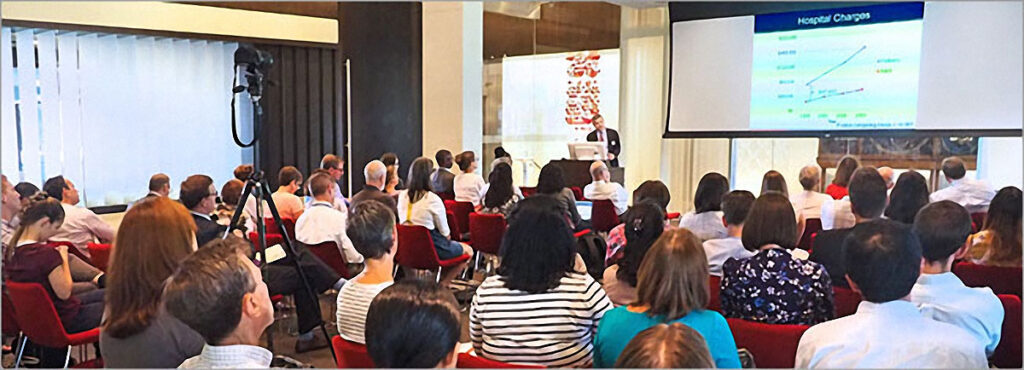
One of nineteen new Leonard Davis Institute of Health Economics (LDI) senior fellows, Children’s Hospital of Philadelphia Cardiac Center Executive Director Joseph Rossano (above) introduces himself at the 2016 LDI “Fall Kickoff” program. Held on the Moelis Terrace of Penn’s Van Pelt-Dietrich Library, the annual event features brief presentations by new senior fellows about their background, research, collaborations and personal life interests. Below (in the order of podium appearance) are photos, audio clips and brief synopses of their remarks.
~ ~ ~
1. Abby Alpert, PhD
Assistant Professor of Health Care Management, Wharton School

MEDICARE PART D AND DIRECT-TO-CONSUMER DRUG ADS
The economics of Medicare and Medicaid-related pharmaceutical policies are the focus of Abby Alpert’s research. “I’m especially interested in the broader and sometimes unintended consequences of these programs,” she said. Alpert, a former Assistant Professor of Economics and Public Policy at the University of California, Irvine, is currently studying Medicare Part D and direct-to-consumer drug advertising aimed at the elderly. “We found substantial effect of advertising on drug utilization. About 70% of this effect is driven by new initiation to treatment, and the remaining 30% is driven by increased drug adherence on existing patients.” However, she also found that patients who initiate treatments because of advertising are actually less compliant with treatments. | See bio page |
2. Juan Pablo Atal, PhD
Economics Lecturer, School of Arts and Sciences
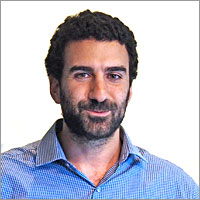
BRINGING A CHILE SENSITIVITY TO PENN ECONOMICS
A native of Chile and recent graduate from the University of California, Berkeley, Atal has just joined Penn’s Economics Department. His current research is focused on long-term health insurance, the determinants of team productivity in emergency departments and the effect of quality regulations on the pharmaceutical market. “I am looking forward to studying and engaging more in research related to the United States,” he said. “But on the other hand, I wanted to shamelessly advertise my country in case any of you are interested in exploring some research topics there.” He noted that according to data from the Organization for Economic Co-operation and Development (OECD), the population of Chile enjoys longer life expectancy than that of the U.S. population. | See bio page |
3. Amy Bleakley, PhD, MPH
Senior Research Scientist, Annenberg School for Communication
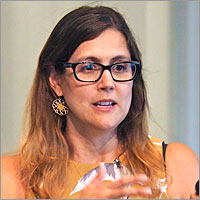
SEX, VIOLENCE, LIQUOR AND MEDIA CONSUMPTION
The effect on youthful behavior of exposure to media portrayals glamorizing violence, sexuality and the consumption of intoxicating substances, is the focus of Bleakley’s current research. She notes that many studies have looked at the association of one of these media portrayals to risky teenage behavior but her project is analyzing how combinations of multiple media portrayals of risky conduct impact offline youth behavior. “So you can all imagine the scenes where James Bond is killing a victim and two seconds later is having sex with a Bond girl,” said Bleakley. “We’re looking at those kinds of portrayals. We’re also focusing on the extent to which exposure to risky media accounts for health disparities between white and African-American youth.” | See bio page |
4. Kathleen Burke, PhD, RN, CENP, FAAN
Assistant Dean for Clinical Nursing Learning and Innovation, Nursing School
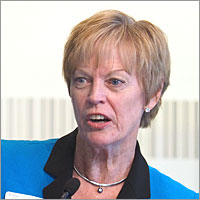
FROM CLINICAL TECHNOLOGY TO PICKLEBALL
As the University of Pennsylvania Health System Corporate Director for Nursing Professional Development and Innovation, Burke continues her career-long interest in the spread of new practices and technologies. When she was a student at Penn’s Nursing School, her dissertation analyzed how the then-new Swan-Ganz catheter became widely used. “I was fascinated to find out there was no evidence that supported the diffusion of this technology and that’s still a problem we have today in health care,” she said. “Nurses impacted the decision-making regarding that catheter… they had a lot of power that they didn’t realize when it came to technology.” On the fun side of her presentation, Burke noted she is a fan of pickleball, a racquet sport combining elements of badminton, tennis and ping-pong. | See bio page |
5. Kit Delgado, MD, MS
Assistant Professor of Emergency Medicine, Perelman School of Medicine
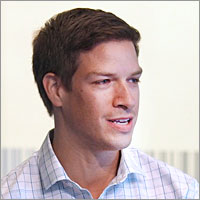
ER DOCTOR BY NIGHT, RESEARCHER BY DAY
Describing himself as “an ER doctor by night and researcher by day,” Delgado’s work as an emergency physician guides his research to find better ways to deliver injury and emergency care related to trauma and the opioid epidemic. In an LDI-funded pilot project, he and his team are analyzing Optum data sets to study the variation in opioid prescribing for acute injuries. “We take the very simple injury of an ankle sprain and look at whether a prescription for an opioid was filled within seven days,” he said. “We looked at the quantity supplied for each prescription and found out there is very substantial state-level variation. New York has a new law limiting prescriptions to no more than a seven day supply. If applied to other states, that could have a significant impact on prescribing.” | See bio page |
6. Hanming Fang, PhD
Term Professor of Economics, School of Arts and Sciences

ST. PETER AND MEDICARE PHYSICIAN TIME SHEETS
Fang spoke about his recent National Bureau of Economic Research Paper entitled “Detecting Potential Overbilling in Medicare Reimbursements via Hours Worked.” Tallying up the timed service codes for Medicare treatments billed to CMS in 2012, Fang found that thousands of physicians submitted claims for clinical services that would have taken more than 100 hours a week to perform. He said the project helped him understand a joke that when a certain lawyer died and arrived at heaven’s gate, St. Peter said “You’re long overdue. We have you as 169 years old.” But the lawyer said, “I’m only 66.” To which St. Peter replied “Up here, age is figured by your time sheets.” On a serious note, Fang emphasized that his analysis system could be easily automated and expanded. | See bio page |
7. John Patrick Fischer, MD
Assistant Professor of Surgery, Perelman School of Medicine
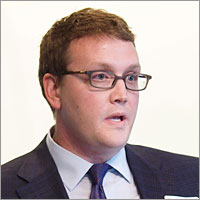
INCISIONAL HERNIA RISK REDUCTION
A plastic surgeon whose practice includes cosmetic and reconstructive procedures, Fischer’s current research is focused on using big data to understand which patients undergoing abdominal surgery are likely to develop incisional hernia. The condition is caused by a weakness in surgical wounds. “We’re working with the Bioinformatics Group to develop point of care instruments that facilitate patient discussion and delivery of state-of-the-art risk reductive interventions,” he said. He noted his excitement about collaborating with LDI to better understand the epidemiology of incisional hernia. Fischer is also involved in patient-centered outcomes and health services research and oversees the Division of Plastic Surgery’s Clinical Research Program. | See bio page |
8. Daniel Holena, MD, FACS
Assistant Professor of Surgery, Division of Traumatology, Surgical Critical Care and Emergency Surgery
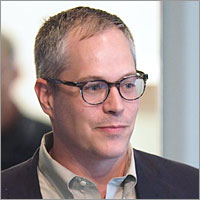
FAILURE TO RESCUE AND THE TRAUMA POPULATION
A trauma surgeon at Penn Presbyterian Medical Center, Holena is currently researching outcomes after emergency surgey and the related metric “failure to rescue” (FTR). FTR is essentially a measure of the quality of clinical vigilance of a patient’s condition, particularly for any signs of deterioration. Holena said part of his project is focused on determining if FTR is being properly applied to the trauma population of patients. For the “fun facts” of his presentation, he said that as a young man he worked as a wrangler on dude ranches in Montana. “It was a lot of fun and I rode a lot of horses and got to see a lot of scenery. But I don’t get to do much of that anymore and I channel that into my children. On the screen he showed his young twin sons at Halloween, dressed as Willie Nelson and Johnny Cash. | See bio page |
9. Daniel Hopkins, PhD
Associate Professor of Political Science, School of Arts and Sciences
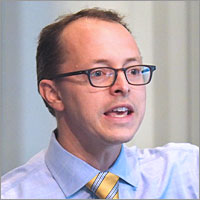
BOOM AND BUST CYCLE OF A POLITICAL SCIENTIST
Hopkins and his research have gotten a lot of press play lately. He is, for instance, co-author of a study of U.S. voters’ attitudes about immigration entitled, “The Hidden American Immigration Consensus.” “As a political scientist,” he said, “I usually toil in obscurity for three years and break surface on the fourth — the election year — when people are suddenly running up to me asking, ‘What’s going to happen?’ ‘Who’s going to win the election?'” His study of public attitudes about the Affordable Care Act found that the law remains “somewhat unpopular among the American public as a whole.” He also works with the White House’s Social & Behavioral Sciences Team that uses health economics’ “nudge” techniques to improve the efficiency and effectiveness of government agencies. | See bio page |
10. Charles Kahn, Jr., MD, MS
Professor and Vice Chairman of Radiology, Perelman School of Medicine
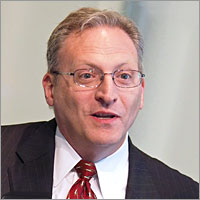
RADIOLOGY REPORT TRANSLATOR SYSTEM FOR PATIENTS
Traditionally, radiology reports are written to be read by other doctors who understand the dense jargon and technical concepts that define the findings and diagnosis. But as patient-centered strategies increasingly make such reports directly accessible to patients via personal online medical records portals, the demand for “translations” into layman’s language are also increasing. Directly addressing this new need, Kahn and his team has developed the PORTER (Patient-Oriented Radiology Reporter), a web-based tool that digitally links layman language annotations and definitions to radiology reports. Kahn’s team has done some preliminary evaluations with Penn patients and continues the system’s development. “We’re actually working to build this into MyPennMedicine so that every radiology report that comes out will have this facility within it,” he said. | See bio page |
11. Robert Krouse, MD, MS, FACS
Chief of Surgery, Philadelphia VA Medical Center
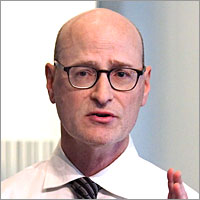
FINE ART AND CANCER RESEARCH
Originally a fine arts major in college, Krouse achieved his “fun fact” quota by punctuating his slide presentation with samples of his paintings from that period. Now the recently arrived Chief of Surgery at the Philadelphia VA Medical Center and Surgery Instructor at Penn’s Perelman School of Medicine, his research focuses on gastrointestinal cancers, skin cancer, quality of life, and end of life care. Skin cancers have become a major interest for him. Krouse noted that because skin cancers are not registry cancers they are not recorded well and “we have no idea” how many actually occur. He said the commonly used microscopically-controlled or “Mohs surgery” for skin cancers “is supposedly tissue sparing but is likely over-utilized in this country in the range of hundreds of millions of dollars. We think there’s a lot of opportunity to really understand better utilization.” | See bio page |
12. Salimah Meghani, PhD
Associate Professor of Behavioral Health Sciences, School of Nursing
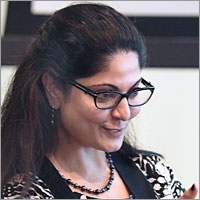
DISPARITIES IN SYMPTOM MANAGEMENT IN VULNERABLE POPULATIONS
Meghani’s fun fact is that she has recently become very interested in astrology and theoretical physics. “If anyone is interested in talking about dark matter or string theory, I welcome you to,” she said. In the wake of her post-doctoral training in health disparities at the Center for Health Disparities Research at Penn’s Nursing School, her current research focuses on palliative care, especially understanding and addressing the sources of disparities in symptom management and outcomes among vulnerable populations. Meghani served as a member of the Institute of Medicine Committee on Approaching Death: Addressing Key End of Life Issues that authored the “Dying in America: Improving Quality and Honoring Individual Preferences Near the End of Life” consensus report. | See bio page |
13. Sushila Murthy, MD, MPH
Assistant Professor of Anesthesiology and Critical Care, Perelman School of Medicine
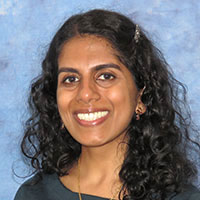
DECISION-MAKING AND GOALS OF ELDERLY SURGERY PATIENTS
An avid bicycle rider, Murthy grew up in Horsham in Montgomery County and did her residency and a fellowship in health services research at Massachusetts General Hospital. Her current research is aimed at better understanding the care, decision-making and goals of elderly surgical patients. “When I was at Mass General,” she said, “one thing I looked at was do we have the right patient? Meaning, have they thought about their own values, goals and preferences? Have they communicated those to the provider? Have they engaged in shared decision-making?” She is now working on a research project that looks at elderly patients with chronic disease who abruptly need surgery with the goal of making the experience more patient-centered. “Possible future directions would be to scale the study up, perhaps using larger data sets and design some type of intervention,” she said. | See bio page |
14. Genevieve Pham-Kanter, PhD
Assistant Professor of Health Management and Policy, Drexel University
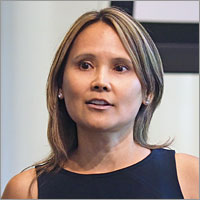
PHYSICIAN FINANCIAL CONFLICTS OF INTEREST
Pham-Kanter’s fun fact is that she was once set up on a date with Bill Nye the Science Guy who hosts the PBS children’s science show. In real life, the health economist researches conflicts of interests in the exchange of payments between health care marketers and physicians. She said about 40% of doctors receive payments of some sort and that there is substantial variation in which kinds of doctors get the money. “Pediatrics is low — it’s about 35% of doctors,” Pham-Kanter said. “Orthopedic surgery is on the high side, about 56% of doctors.” Looked at from the point of view of the patients, Pham-Kanter said 65% of U.S. patients visit doctors who receive such industry payments; and nine out of ten patients who see an orthopedic surgeon are interacting with someone who has accepted industry money. | See bio page |
15. Graham Quinn, MD
Professor of Opthalmology, Children’s Hospital of Philadelphia
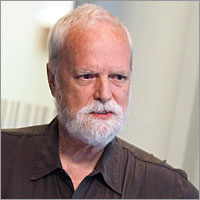
ROP BLINDNESS IN PREMATURE INFANTS
Quinn, a specialist in “Retinopathy of Prematurity” or ROP, relaxes from his work and research by traveling and taking cooking classes in faraway places. He became interested in ROP during an early-career fellowship. The condition causes blindness driven by the growth of abnormal blood vessels in premature infants’ retinas. “We are in the midst of another epidemic of blindness related to ROP,” said Quinn. “The preemies you have to worry about are not the ones in our country or in low-income countries where they don’t survive. The ones you need to worry about are in middle-income countries that are just developing neonatal care.” Quinn has pioneered the use of telemedicine techniques that can detect ROP and allow for treatments that can prevent blindness. | See bio page |
16. Joseph Rossano, MD, MS
Executive Director of the Cardiac Center, Children’s Hospital of Philadelphia
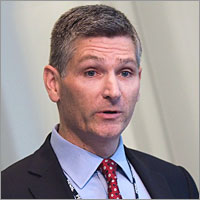
CHILDHOOD vs. ADULT HEART FAILURE HOSPITALIZATIONS
The director of a heart and liver transplant program, Rossano’s research focuses on the epidemiology and outcomes of childhood cardiovascular disease treatments. He noted that in heart failure incidents, children fare far worse than adults. “Looking at thousands and thousands of hospitalizations, the data were striking,” Rossano said. “The average length of time a child was in the hospital was so much longer than adults. An average eight-year-old who is hospitalized with heart failure is in the hospital several times longer than a 75-year-old hospitalized for heart failure. Because hospital length of stay is the biggest driver of costs, pediatric heart failure hospitalizations are so much more expensive. And it’s just getting worse over time if you look at data from the last decade.” | See bio page |
17. Kira Ryskina, MD
Assistant Professor of General Internal Medicine, Perelman School
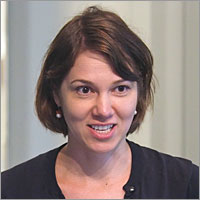
STUDYING PHYSICIAN BEHAVIOR AND PRACTICE VARIATIONS
A native of Baku, Azerbaijan, Ryskina’s research focuses on physician behavior and the social determinants of health. “During my residency in New York, I became aware and really interested in understanding why there is so much variation in physician practice and how physicians make decisions, especially where there is not a lot of clear clinical benefit with one option or another,” she said. “Physicians’ decisions drive about 80% of health care spending and a lot of that utilization is considered unnecessary or low value. It doesn’t lead to patient benefit. So my research is trying to understand environmental factors that might explain or impact physician practice, look at how training affects physician behavior and look at regional and local practice characteristics.” | See bio page |
18. Dominic Sisti, PhD
Assistant Professor of of Medical Ethics & Health Policy, Perelman School of Medicine
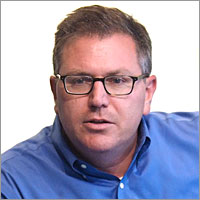
ASYLUMS, PRISONS AND THE MENTALLY ILL
“I’m a recovering philosopher who now tries to actually change the world a little and I work primarily at the intersection of behavioral health care and ethics and philosophy,” Sisti said. The Director of the Scattergood Program for the Applied Ethics of Behavioral Healthcare, his currently research is an LDI-funded pilot project focused on mental health care in prisons. Sisti explained that 20% to 30% of the current U.S. incarcerated population suffers serious mental illness. His charts detailed how, over the 50s and 60s as the number of beds in mental health facilities dwindled, the number of individuals incarcerated with serious mental illnesses increased. Sisti recently stirred controversy as co-author of a paper entitled “Improving Long-Term Psychiatric Care: Bring Back the Asylum.” | See bio page |
19. Robin Stevens, PhD, MPH
Assistant Professor of Nursing, School of Nursing
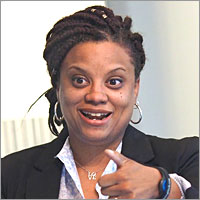
RESEARCH FROM THE DIGITAL HOOD
Stevens specializes in studying how public health and both traditional and new forms of digital communications influence adolescent risk behaviors. She is Director of Penn’s Health Equity & Media Lab. “I study the social media environment and the social world of adolescents, particularly black and brown adolescents, who are trying to overcome certain health disparities and inequities around sex, drug use and thriving in sometimes resource-deprived neighborhoods,” she said. “This space is the perfect nexus of entertainment media, interpersonal communications and a lot of other crazy things. We know teens are learning and modeling behavior and picking up norms about everything from their peers and from the media.” | See bio page |







